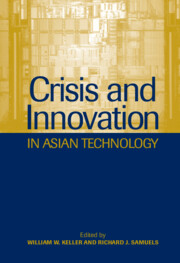Book contents
- Frontmatter
- Contents
- Figures and Tables
- Contributors
- Acknowledgments
- 1 Innovation and the Asian Economies
- 2 Japanese Production Networks in Asia: Extending the Status Quo
- 3 Crisis and Innovation in Japan: A New Future through Technoentrepreneurship?
- 4 Crisis, Reform, and National Innovation in South Korea
- 5 From National Champions to Global Partners: Crisis, Globalization, and the Korean Auto Industry
- 6 Crisis and Adaptation in Taiwan and South Korea: The Political Economy of Semiconductors
- 7 China in Search of a Workable Model: Technology Development in the New Millennium
- 8 Economic Crisis and Technological Trajectories: Hard Disk Drive Production in Southeast Asia
- 9 Continuity and Change in Asian Innovation
- Index
1 - Innovation and the Asian Economies
Published online by Cambridge University Press: 15 December 2009
- Frontmatter
- Contents
- Figures and Tables
- Contributors
- Acknowledgments
- 1 Innovation and the Asian Economies
- 2 Japanese Production Networks in Asia: Extending the Status Quo
- 3 Crisis and Innovation in Japan: A New Future through Technoentrepreneurship?
- 4 Crisis, Reform, and National Innovation in South Korea
- 5 From National Champions to Global Partners: Crisis, Globalization, and the Korean Auto Industry
- 6 Crisis and Adaptation in Taiwan and South Korea: The Political Economy of Semiconductors
- 7 China in Search of a Workable Model: Technology Development in the New Millennium
- 8 Economic Crisis and Technological Trajectories: Hard Disk Drive Production in Southeast Asia
- 9 Continuity and Change in Asian Innovation
- Index
Summary
This book is about crisis and choice, an enduring relationship in world politics and, especially, in economic change. Modern social science is filled with “shock adjustment” metaphors invoked to characterize the ways in which change occurs. Much like our understanding of evolutionary biology, notions of “punctuated equilibrium” or “paradigm shifts” presume that significant institutional and normative adjustments follow sudden major challenges to a previously stable system. War is the most common “punctuation.” We speak confidently of a post—World War II world that operated under different rules (as set by the superpower confrontation) and with different institutions (e.g., those of Bretton Woods) than the prewar one. New ideas, such as Keynesianism or communism, can have the same effect.
Similarly, technological innovations — in transportation, communication, or other elements of infrastructure — can also provide dramatic “punctuation” of a stable order. Entrepreneurs had different expectations of markets before the Industrial Revolution than later, before the diffusion of railways or of telephones than afterward, or prior to the introduction of just-in-time production than they do today. Similarly, microelectronics and then the Internet each transformed the business models deployed for generating wealth and profit. In each case, new technology led to the redistribution of economic and political power. New products, like new world orders, can transform what we believe to be the “normal” social, political, and economic conditions within which we make choices.
- Type
- Chapter
- Information
- Crisis and Innovation in Asian Technology , pp. 1 - 22Publisher: Cambridge University PressPrint publication year: 2003
- 21
- Cited by



